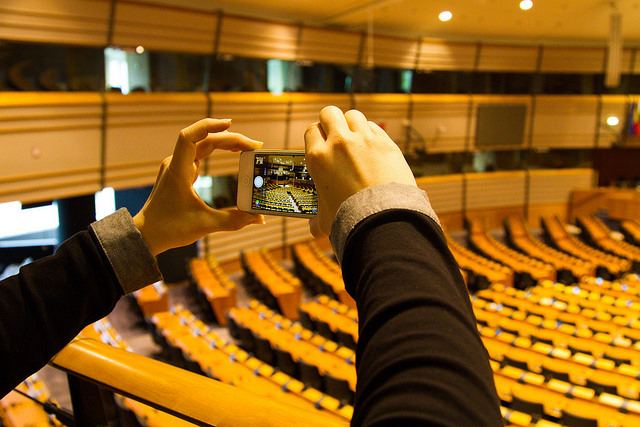The European Parliament’s transnational party groups are surprisingly cohesive, but don’t underestimate the potential for national divisions
Members of the European Parliament (MEPs) do not sit in country blocs, rather they sit in pan-European ideological party groupings. But how cohesive are these groups? Rory Costello and Robert Thomson argue that they are remarkably so – but that the potential for divides along national lines is great, particularly with MEPs who share a party with their country’s government.
Despite the diversity of their members, transnational political groups in the European Parliament (EP) have remarkably cohesive voting records. Organised along left-right lines and including MEPs from at least one-quarter of member states, these groups structure decision-making in the EP. The high level of cohesion exhibited by these groups offers hope to those who would like to see a genuinely European system of representation emerging in the EP, with the preferences of European citizens channelled through transnational parties.
Yet some have argued that the cohesion of these political groups is not down to shared preferences of their members or the ability of party groups to enforce discipline, but is rather a consequence of MEPs lack of preferences on many issues (Ringe, 2010). Much of the EP’s legislative business concerns highly technical regulatory matters. Furthermore, compromise deals are usually negotiated behind closed-doors by a small team of delegates from each institution, and MEPs are asked to vote on these agreements without knowing much about how they were reached. Under these conditions, MEPs may simply take their voting cues from their party group leadership because it is the easiest option.
This is a very fragile basis for party group cohesion. If the public profile of the EP grows and more voters begin to pay attention to how MEPs vote, they will be less willing to follow blindly the party group line. The growing power of the EP also means that MEPs are increasingly lobbied by national-level actors. As they are elected in national constituencies, MEPs are likely to be receptive to pressure from domestic sources.
To shed light on the nature of party group cohesion in the EP, our research looks in-depth at a range of controversial legislative issues negotiated in recent years. Rather than simply relying on voting records, we interviewed participants to identify the initial policy positions adopted by the various national parties in each of the main party groups. We also examined the policy positions taken by the national governments in the other main legislative body, the Council of Ministers. As the primary arena where national interests are expressed, we are particularly interested in how and when national divisions in the Council are replicated in the EP.
Two main findings emerge from our research. First, it is relatively rare for significant national divisions to occur within the transnatinal party groups of the EP. This is despite the fact that we focused on high-profile and controversial pieces of legislation in our research. The high levels of cohesion exhibited in voting records are therefore not the result of MEPs being ‘whipped’ into line by the party groups. Nor is it the result of bias in voting records, as some have suggested. Rather, we find that national parties within the transnational EP groups are generally happy to go along with the party group position. National parties disagreed with their transnatinoal party group during negotiations on only 16% of the cases we examined; and usually these disagreements remained when it came to voting.
Our second finding is that MEPs are far more likely to go against their party group position when they come under pressure from their government representatives in the Council. This is true particularly for MEPs from governing national parties, but we also observe it for MEPs from opposition parties. The likelihood of a national party disagreeing with its party group is significantly higher on issues that are important to the national government, and when the government is isolated in the Council. If a government is in a weak negotiating position in the Council, it may direct more attention to lobbying MEPs. Our evidence suggests that MEPs often respond to such pressure from their government representatives.
There is no doubt that transnational party groups in the EP have developed into cohesive entities. However, the major fault-lines in the EU as a whole remain territorial rather than ideological. The primary outlets for these national divisions are the Council of Ministers and the European Council, but they can also emerge in the EP. Increasingly, the EP is involved in issues that touch on core national interests such as agriculture, migration and fiscal policy. MEPs may therefore come under greater pressure from national actors in the future, and our research suggests that this will pose a significant challenge to the cohesion of EP party groups.
—
This article gives the views of the authors, and not the position of Democratic Audit UK, nor of the London School of Economics. Please read our comments policy before posting.
—
 Rory Costello is a lecturer in the Department of Politics and Public Administration at the University of Limerick.
Rory Costello is a lecturer in the Department of Politics and Public Administration at the University of Limerick.
 Robert Thomson is Professor of Politics at the School of Government and Public Policy, University of Strathclyde.
Robert Thomson is Professor of Politics at the School of Government and Public Policy, University of Strathclyde.






 Democratic Audit's core funding is provided by the Joseph Rowntree Charitable Trust. Additional funding is provided by the London School of Economics.
Democratic Audit's core funding is provided by the Joseph Rowntree Charitable Trust. Additional funding is provided by the London School of Economics.
Article in Democratic Audit UK summarising recent research on the European Parliament by Rory Costello and Robert… https://t.co/W21uEJ4uPK
The European Parliament’s transnational party groups are cohesive, but strong potential for national divisions https://t.co/jLUPCVJ3FJ
The complete lack of any knowledge of the European Parliament by voters, specially in countries like the UK (but one suspects elsewhere as well), means that the shadowy processes of a largely irrelevant institution which is designed as a figleaf to affect ‘democracy’ in the EU can continue with very little oversight.
How much coverage is given to the antics of the EP either in the press or on tv? Practically zero, other than for periodic obligation/advertorial style coverage by state radio and tv (“do we have to?” sigh those working on the programme. “Yes, it’s the obligatory 90 second spot once every 6 months,” says producer. “I know it’s too much time to give to the institution when valuable and interesting things about Harper Beckham’s ad deal or Ginger Spice’s new frock are obviously more important, but we are obliged by our Charter. Etc etc”. How many voters actually know who their local MEPs are?
.@Europarl_EN transnational party groups are surprisingly cohesive (via @democraticaudit) https://t.co/afpAJQ5B4a
The EP’s transnational party groups surprisingly cohesive, but don’t underestimate the potential for nat divisions https://t.co/krjHWK5J97
The European Parliament’s transnational party groups are surprisingly cohesive, but don’t underestimate the potent… https://t.co/79zBczQUv6
The European Parliament’s transnational party groups are surprisingly cohesive, but don’t underestimate the po… https://t.co/bpxMiYSreZ
European Parliament’s transnational party groups are surprisingly cohesive, but still potential national divisions https://t.co/8gD7fPGzBW
The European Parliament’s transnational party groups are surprisingly cohesive, but don’t… https://t.co/FcAl06tOVQ https://t.co/nN2B3qk4dq